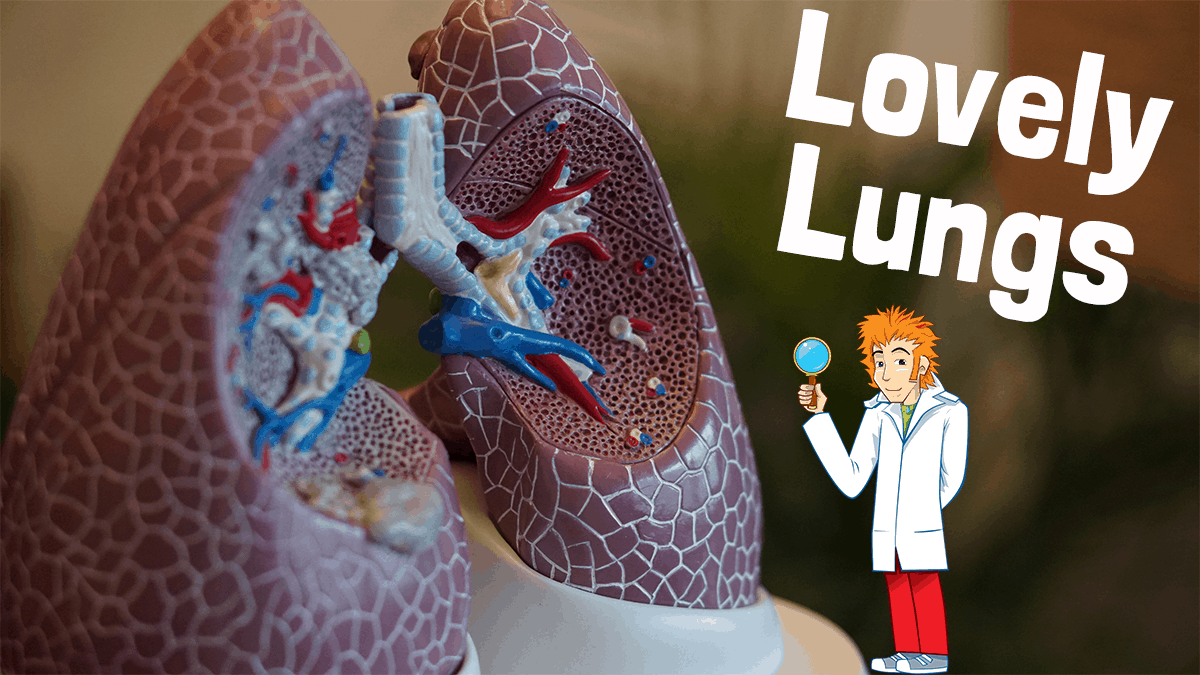 Hello again medicine fans and welcome to my blog post about building my very own human body.
Hello again medicine fans and welcome to my blog post about building my very own human body.
Today Nurse Nanobot and I added a lovely set of lungs so that our body can breathe and talk, and get lots of awesome oxygen in to keep those organs motoring.
Press the play button above to listen to us exploreyour lovely lungs and also read loads of interesting facts below!
Your lungs sit in your chest under your ribs. If you lay a hand on your chest you can feel the lungs filling with air and expelling it – about twelve times a minute.
What happens when we breathe?
Air comes in your mouth and nose as you breathe, into your trachea – that’s your windpipe.
It then goes down into your chest where the trachea divides into two bronchii – small tubes that feed your left and right lungs.
From here, like a tree’s branches the bronchii divide into a total of about 30,000 smaller tubes called bronchioles , each the width of a hair – and from there into 600 million alveoli – these are like tiny bags where the oxygen passes into the bloodstream over a mesh of fine blood vessels called capillaries to power every organ in your body.
With every breath out the waste carbon dioxide from the blood is ejected out of your mouth, keeping the blood healthy.
Did you know your left lung is smaller? That’s because there has to be enough room for your heart on that side – I’m just fitting the lungs into my body now – it’s certainly a squash and a squeeze!
Asthma
Maybe you or someone you know has asthma. People who have asthma find that all those little tubes and pockets get inflamed and then it can be a struggle to get the air in.
Medicine can be sprayed into the lungs using an inhaler which calms the inflammation and allows air to enter so it is important to keep your inhaler to hand if you have asthma.
Diaphragm
The diaphragm, which is a big domed muscle, pushes and stretches the lungs to breathe. When the diaphragm relaxes, the lungs are pulled open and air is pulled in – that’s breathing in, and when the diaphragm tightens the air in your lungs is pushed upwards and out – that’s breathing out.
The faster cars go, the more petrol they need. In the same way, the harder your body is working, the more oxygen your organs need. This is why you breathe harder and faster when running, or when you are excited or scared.
How We Make Sounds
Your larynx, or voice box sits above the trachea and all across it are little ridges called the vocal chords.
These vibrate as air passes to make sound. They also open and close to determine what sound comes out your mouth.
Your teeth and tongue finish the job and shape these noises into words. Giggling is small pockets of air passing over the chords, and burping is one long breath, right from your oesophagus actually, not your trachea.
Nurse Nanobot’s Orrible Old Anatomy Fact
In the 1600s a scientist called Robert Boyle discovered that living things needed oxygen.
As was the fashion at the time, he would perform grand experiments in public to demonstrate, often using a bird in a bell jar. He’d create a vacuum by sucking the air out and the bird would die – poor bird!
There is a famous painting of the experiment in the National Gallery in London, by an artist called Joseph Wright. It’s called An Experiment on a Bird in the Air Pump.
If you’re an animal lover you’ll be glad to hear that it was more normal to use a balloon in the bell jar instead of an animal!
Disgusting Details
Did you know that if people who live near volcanoes breath in volcanic dust?
This can lead to a rare illness with a very long name – pneumonoultramicroscopicsilicovolcanoconiosis!
And that’s the longest word in medicine!
You can listen to Professor Hallux on:
- Fun Kids Radio
- iTunes
- RSS
- or listen to the series below!
> Visit the Professor Hallux Builds a Body Homepage
> Download the free Builds a Body podcast from iTunes
Professor Hallux Builds a Body
Find out out how to build a human body with Professor Hallux and Fun Kids
More From Professor Hallux Builds a Body



